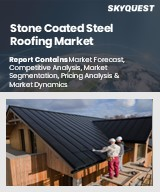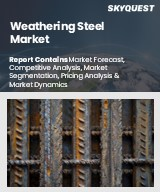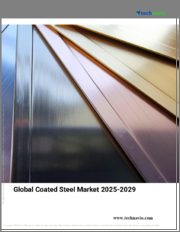
|
시장보고서
상품코드
1679496
코팅 강판 시장 : 시장 규모, 점유율, 동향 분석 보고서 - 제품별, 최종 용도별, 지역별, 부문 예측(2025-2030년)Coated Steel Market Size, Share & Trend Analysis Report By Product (Galvanized, Pre-painted), By End Use (Automotive, Building & Construction), By Region (North America, Europe, Asia Pacific), And Segment Forecasts, 2025 - 2030 |
||||||
코팅 강판 시장의 성장 및 동향
Grand View Research, Inc.의 최신 보고서에 따르면 세계의 코팅 강판 시장 규모는 2030년까지 4,319억 6,000만 달러에 달할 것으로 예측되며, 2025-2030년 CAGR 6.9%를 나타낼 것으로 예측됩니다. 이것은 내구성이 있고, 녹이 잘 슬지 않으며, 심미적으로 매력적인 재료에 대한 수요 증가가 원동력이 되고 있습니다. 아연 도금, 도장 완료, 전기 아연 도금 강판 등의 코팅 강판은 내식성 강화, 내구성 향상, 가혹한 환경 조건에 대한 내성을 기재하고 있습니다. 이러한 특성으로 인해 코팅 강판은 건설, 자동차, 소비자용 전자 기기, 인프라 등 다양한 산업에 이상적입니다. 세계 경제의 회복에 따라 신흥국 시장에서도 선진국 시장에서도 고성능 재료에 대한 요구가 높아지고 있습니다.
건설 산업은 특히 지붕, 클래딩 및 구조 부재의 제조에서 코팅 강판의 최대 소비자 중 하나입니다. 코팅 강판은 미관을 유지하면서 극단적 인 기상 조건을 견딜 수 있기 때문에 선호됩니다. 또한, 친환경 건축 동향은 지속 가능한 건축자재 수요를 뒷받침하고 있으며, 코팅 강판은 목재 및 플라스틱과 같은 대체품보다 친환경 선택이 되었습니다. 방청 코팅의 개량 등, 코팅 기술의 끊임없는 혁신이 이 부문에 있어서 코팅 강판의 채용에 더욱 기여하고 있습니다.
자동차 산업에서는 우수한 강도 대 중량비와 내식성으로 인해 코팅 강판의 사용이 급증하고 있습니다. 코팅 강판은 차체 패널, 섀시 및 구조 부품에 널리 사용됩니다. 연비 효율 및 자동차의 안전성에 대한 주목이 높아지는 가운데, 제조업체는 경량이면서 내구성이 있는 재료를 요구하고 있어, 코팅 강판은 이상적인 선택지가 되고 있습니다. EV 수요 증가 및 자동차 생산에서 첨단 재료의 통합은 제조업체가 현대 운송의 까다로운 요구에 부응하기 위해 노력하고 있기 때문에 코팅 강판 산업을 더욱 강화하고 있습니다.
소비자용 전자기기 시장도 코팅 강판 산업의 중요한 촉진요인입니다. 냉장고, 세탁기, 식기세척기, 오븐에 코팅 강판이 널리 사용되고 있는 것은 내부식성, 유지보수의 용이함, 복잡한 형태로 성형할 수 있는 능력에 의한 점이 큽니다. 소비자가 오래 지속되고 에너지 효율이 높고 외형에 아름다운 소비자용 전자기기 제품을 요구하는 가운데 코팅 강판이 선호되고 있습니다. 게다가 첨단 기능과 연결성을 지원하는 재료를 필요로 하는 스마트 소비자용 전자기기의 대두로 고품질의 코팅 강판 부품에 대한 수요가 높아지고 있습니다.
지역별로 코팅 강판 산업은 아시아태평양이 세계 수요의 최대 점유율을 차지하고 있습니다. 중국, 인도, 일본 등의 국가들은 대규모 산업 기반 및 급속한 도시화로 코팅 강판의 주요 생산자 및 소비자가 되었습니다. 북미와 유럽은 특히 자동차 및 건설 용도에서 코팅 강판의 주요 시장입니다. 이러한 지역이 인프라 및 제조 능력을 현대화하고 지속가능성을 중시하며 다양한 산업에서 첨단 재료를 사용함에 따라 시장은 계속 확대될 것으로 예상됩니다.
코팅 강판 시장 보고서 하이라이트
- 제품별로는 아연 도금 강판이 2024년에 81.0% 이상의 수익 점유율을 차지하며 시장을 독점했습니다. 이는 건설, 자동차 및 인프라 부문에서 내부식성 재료 수요가 증가하고 있기 때문입니다.
- 최종 용도별로는 건축 및 건설 분야가 2024년에 41.0%가 넘는 점유율을 차지해, 시장을 독점했습니다. 이것은 급속한 도시화, 주택 및 상업 프로젝트에 있어서 내구성, 심미성, 에너지 효율이 뛰어난 재료에 대한 수요 증가가 요인입니다.
- 아시아태평양은 합금강 시장의 지배적인 지역이며 2024년에는 66.0% 이상의 수익 점유율을 차지했습니다. 특히 중국, 인도, 일본 등의 나라에서는 급속한 공업화가 진행되어 자동차, 건설, 제조업에서의 강판 수요가 증가하고 있습니다.
- 주요 산업 참가자는 ArcelorMittal, Baosteel Group, ChinaSteel, Essar Steel, Tata Steel, Nucor, Voestalpine AG 등입니다.
목차
제1장 조사 방법 및 범위
제2장 주요 요약
제3장 시장의 변수, 동향 및 범위
- 세계의 코팅 강판 시장 전망
- 산업 밸류체인 분석
- 원료의 동향
- 유통 채널 분석
- 기술 개요
- 규제 프레임워크
- 시장 역학
- 시장 성장 촉진요인 분석
- 시장 성장 억제요인 분석
- 시장 기회 분석
- 시장의 과제
- Porter's Five Forces 분석
- 공급기업의 협상력
- 구매자의 협상력
- 대체 위협
- 신규 참가업체의 위협
- 경쟁 기업간 경쟁 관계
- PESTLE 분석
- 정치
- 경제
- 사회
- 기술
- 환경
- 법률
제4장 코팅 강판 시장 : 제품별 추정 및 동향 분석
- 코팅 강판 시장 : 제품별 변동 분석(2024년, 2030년)
- 아연 도금
- 도장
- 기타
제5장 코팅 강판 시장 : 최종 용도별 추정 및 동향 분석
- 코팅 강판 시장 : 최종 용도별 변동 분석(2024년, 2030년)
- 자동차
- 건축 및 건설
- 소비자용 전자기기 제품
- 기타
제6장 코팅 강판 시장 : 지역별 추정 및 동향 분석
- 지역별 분석(2024년, 2030년)
- 북미
- 제품별(2018-2030년)
- 최종 용도별(2018-2030년)
- 미국
- 캐나다
- 멕시코
- 유럽
- 제품별(2018-2030년)
- 최종 용도별(2018-2030년)
- 독일
- 프랑스
- 러시아
- 이탈리아
- 아시아태평양
- 제품별(2018-2030년)
- 최종 용도별(2018-2030년)
- 중국
- 인도
- 일본
- 인도네시아
- 중남미
- 제품별(2018-2030년)
- 최종 용도별(2018-2030년)
- 브라질
- 중동 및 아프리카
- 제품별(2018-2030년)
- 최종 용도별(2018-2030년)
- 사우디아라비아
제7장 경쟁 구도
- 주요 시장 진출기업에 의한 최근 동향 및 영향 분석
- 기업 분류
- 히트맵 분석
- 벤더 상황
- 장비 공급업체 목록
- 판매점 일람
- 잠재적 최종 사용자 목록
- 최종 사용자별 전략 이니셔티브
- 기업 프로파일 및 상장 기업
- ArcelorMittal
- Baosteel Group
- ChinaSteel
- Essar Steel
- JFE Steel Corporation
- JSW
- Kobe Steel Ltd.
- Nippon Steel Corporation
- Nucor
- OJSC Novolipetsk Steel
- POSCO
- Severstal
- SSAB AB
- Tata Steel
- voestalpine AG
Coated Steel Market Growth & Trends:
The global coated steel market size is anticipated to reach USD 431.96 billion by 2030 and is projected to grow at a CAGR of 6.9% from 2025 to 2030, according to a new report by Grand View Research, Inc. It is driven by the increasing demand for durable, rust-resistant, and aesthetically appealing materials. Coated steel products, such as galvanized, pre-painted, and electro-galvanized steel, offer enhanced corrosion resistance, improved durability, and the ability to withstand harsh environmental conditions. These features make coated steel ideal for various industries, including construction, automotive, home appliances, and infrastructure. As the global economy recovers, there is a growing need for high-performance materials in both emerging and developed markets.
The construction industry has become one of the largest consumers of coated steel, particularly in manufacturing roofing, cladding, and structural elements. Coated steel is preferred due to its ability to withstand extreme weather conditions while maintaining its aesthetic qualities. In addition, the trend towards green building practices has driven the demand for sustainable construction materials, with coated steel being a more eco-friendly option than alternatives like wood or plastic. The continuous innovation in coating technologies, such as improved anti-corrosion coatings, has further contributed to the adopting of coated steel in the sector.
In the automotive industry, the use of coated steel is growing rapidly due to its excellent strength-to-weight ratio and resistance to corrosion. Coated steel sheets are widely used in car body panels, chassis, and structural components. With the increasing focus on fuel efficiency and vehicle safety, manufacturers are looking for lightweight yet durable materials, making coated steel an ideal choice. The rising demand for EVs and the integration of advanced materials in vehicle production further boost the coated steel industry as manufacturers strive to meet the rigorous demands of modern transportation.
The home appliances market is also a significant driver of the coated steel industry. The widespread use of coated steel in refrigerators, washing machines, dishwashers, and ovens is largely due to its resistance to corrosion, easy maintenance, and ability to be molded into complex shapes. As consumers seek long-lasting, energy-efficient, and visually appealing appliances, coated steel is preferred. In addition, the rise of smart home appliances, which often require materials that support advanced features and connectivity, has created a growing demand for high-quality, coated steel components.
Regionally, the coated steel industry is dominated by Asia-Pacific, which accounts for the largest share of global demand. Countries like China, India, and Japan are major producers and consumers of coated steel due to their large industrial bases and rapid urbanization. North America and Europe are also key markets for coated steel, particularly in automotive and construction applications. The market is expected to continue expanding as these regions modernize their infrastructure and manufacturing capabilities, emphasizing sustainability and using advanced materials in various industries.
Coated Steel Market Report Highlights:
- Based on product, galvanized steel dominated the market with a revenue share of over 81.0% in 2024 due to the increasing demand for corrosion-resistant materials in the construction, automotive, and infrastructure sectors.
- Based on end use, the building & construction sector dominated the market with a share of over 41.0% in 2024, driven by rapid urbanization and the growing demand for durable, aesthetically pleasing, and energy-efficient materials for residential and commercial projects.
- Asia Pacific is the dominant region for the alloy steel market, with a revenue share of over 66.0% in 2024, driven by rapid industrialization, particularly in countries such as China, India, and Japan, where demand for steel in automotive, construction, and manufacturing is growing.
- Key industry participants include ArcelorMittal, Baosteel Group, ChinaSteel, Essar Steel, Tata Steel, Nucor, and Voestalpine AG, among others.
Table of Contents
Chapter 1. Methodology and Scope
- 1.1. Market Segmentation & Scope
- 1.2. Market Definition
- 1.3. Information Procurement
- 1.3.1. Information Analysis
- 1.3.2. Data Analysis Models
- 1.3.3. Market Formulation & Data Visualization
- 1.3.4. Data Validation & Publishing
- 1.4. Research Scope and Assumptions
- 1.4.1. List of Data Sources
Chapter 2. Executive Summary
- 2.1. Market Outlook
- 2.2. Segmental Outlook
- 2.3. Competitive Outlook
Chapter 3. Market Variables, Trends, and Scope
- 3.1. Global Coated Steel Market Outlook
- 3.2. Industry Value Chain Analysis
- 3.2.1. Raw Material Trends
- 3.2.2. Sales Channel Analysis
- 3.3. Technology Overview
- 3.4. Regulatory Framework
- 3.5. Market Dynamics
- 3.5.1. Market Driver Analysis
- 3.5.2. Market Restraint Analysis
- 3.5.3. Market Opportunity Analysis
- 3.5.4. Market Challenges
- 3.6. Porter's Five Forces Analysis
- 3.6.1. Bargaining Power of Suppliers
- 3.6.2. Bargaining Power of Buyers
- 3.6.3. Threat of Substitution
- 3.6.4. Threat of New Entrants
- 3.6.5. Competitive Rivalry
- 3.7. PESTLE Analysis
- 3.7.1. Political
- 3.7.2. Economic
- 3.7.3. Social Landscape
- 3.7.4. Technology
- 3.7.5. Environmental
- 3.7.6. Legal
Chapter 4. Coated Steel Market: Product Estimates & Trend Analysis
- 4.1. Coated Steel Market: Product Movement Analysis, 2024 & 2030
- 4.2. Galvanized
- 4.2.1. Market estimates and forecasts, 2018 - 2030 (Kilotons) (USD Million)
- 4.3. Pre-painted
- 4.3.1. Market estimates and forecasts, 2018 - 2030 (Kilotons) (USD Million)
- 4.4. Others
- 4.4.1. Market estimates and forecasts, 2018 - 2030 (Kilotons) (USD Million)
Chapter 5. Coated Steel Market: End Use Estimates & Trend Analysis
- 5.1. Coated Steel Market: End Use Movement Analysis, 2024 & 2030
- 5.2. Automotive
- 5.2.1. Market estimates and forecasts, 2018 - 2030 (Kilotons) (USD Million)
- 5.3. Building & Construction
- 5.3.1. Market estimates and forecasts, 2018 - 2030 (Kilotons) (USD Million)
- 5.4. Appliances
- 5.4.1. Market estimates and forecasts, 2018 - 2030 (Kilotons) (USD Million)
- 5.5. Others
- 5.5.1. Market estimates and forecasts, 2018 - 2030 (Kilotons) (USD Million)
Chapter 6. Coated Steel Market: Regional Estimates & Trend Analysis
- 6.1. Regional Analysis, 2024 & 2030
- 6.2. North America
- 6.2.1. Market estimates and forecasts, 2018 - 2030 (Kilotons) (USD Million)
- 6.2.2. Market estimates and forecasts, by product, 2018 - 2030 (Kilotons) (USD Million)
- 6.2.3. Market estimates and forecasts, by end use, 2018 - 2030 (Kilotons) (USD Million)
- 6.2.4. U.S.
- 6.2.4.1. Market estimates and forecasts, 2018 - 2030 (Kilotons) (USD Million)
- 6.2.4.2. Market estimates and forecasts, by product, 2018 - 2030 (Kilotons) (USD Million)
- 6.2.4.3. Market estimates and forecasts, by end use, 2018 - 2030 (Kilotons) (USD Million)
- 6.2.5. Canada
- 6.2.5.1. Market estimates and forecasts, 2018 - 2030 (Kilotons) (USD Million)
- 6.2.5.2. Market estimates and forecasts, by product, 2018 - 2030 (Kilotons) (USD Million)
- 6.2.5.3. Market estimates and forecasts, by end use, 2018 - 2030 (Kilotons) (USD Million)
- 6.2.6. Mexico
- 6.2.6.1. Market estimates and forecasts, 2018 - 2030 (Kilotons) (USD Million)
- 6.2.6.2. Market estimates and forecasts, by product, 2018 - 2030 (Kilotons) (USD Million)
- 6.2.6.3. Market estimates and forecasts, by end use, 2018 - 2030 (Kilotons) (USD Million)
- 6.3. Europe
- 6.3.1. Market estimates and forecasts, 2018 - 2030 (Kilotons) (USD Million)
- 6.3.2. Market estimates and forecasts, by product, 2018 - 2030 (Kilotons) (USD Million)
- 6.3.3. Market estimates and forecasts, by end use, 2018 - 2030 (Kilotons) (USD Million)
- 6.3.4. Germany
- 6.3.4.1. Market estimates and forecasts, 2018 - 2030 (Kilotons) (USD Million)
- 6.3.4.2. Market estimates and forecasts, by product, 2018 - 2030 (Kilotons) (USD Million)
- 6.3.4.3. Market estimates and forecasts, by end use, 2018 - 2030 (Kilotons) (USD Million)
- 6.3.5. France
- 6.3.5.1. Market estimates and forecasts, 2018 - 2030 (Kilotons) (USD Million)
- 6.3.5.2. Market estimates and forecasts, by product, 2018 - 2030 (Kilotons) (USD Million)
- 6.3.5.3. Market estimates and forecasts, by end use, 2018 - 2030 (Kilotons) (USD Million)
- 6.3.6. Russia
- 6.3.6.1. Market estimates and forecasts, 2018 - 2030 (Kilotons) (USD Million)
- 6.3.6.2. Market estimates and forecasts, by product, 2018 - 2030 (Kilotons) (USD Million)
- 6.3.6.3. Market estimates and forecasts, by end use, 2018 - 2030 (Kilotons) (USD Million)
- 6.3.7. Italy
- 6.3.7.1. Market estimates and forecasts, 2018 - 2030 (Kilotons) (USD Million)
- 6.3.7.2. Market estimates and forecasts, by product, 2018 - 2030 (Kilotons) (USD Million)
- 6.3.7.3. Market estimates and forecasts, by end use, 2018 - 2030 (Kilotons) (USD Million)
- 6.4. Asia Pacific
- 6.4.1. Market estimates and forecasts, 2018 - 2030 (Kilotons) (USD Million)
- 6.4.2. Market estimates and forecasts, by product, 2018 - 2030 (Kilotons) (USD Million)
- 6.4.3. Market estimates and forecasts, by end use, 2018 - 2030 (Kilotons) (USD Million)
- 6.4.4. China
- 6.4.4.1. Market estimates and forecasts, by product, 2018 - 2030 (Kilotons) (USD Million)
- 6.4.4.2. Market estimates and forecasts, by end use, 2018 - 2030 (Kilotons) (USD Million)
- 6.4.5. India
- 6.4.5.1. Market estimates and forecasts, by product, 2018 - 2030 (Kilotons) (USD Million)
- 6.4.5.2. Market estimates and forecasts, by end use, 2018 - 2030 (Kilotons) (USD Million)
- 6.4.6. Japan
- 6.4.6.1. Market estimates and forecasts, by product, 2018 - 2030 (Kilotons) (USD Million)
- 6.4.6.2. Market estimates and forecasts, by end use, 2018 - 2030 (Kilotons) (USD Million)
- 6.4.7. Indonesia
- 6.4.7.1. Market estimates and forecasts, by product, 2018 - 2030 (Kilotons) (USD Million)
- 6.4.7.2. Market estimates and forecasts, by end use, 2018 - 2030 (Kilotons) (USD Million)
- 6.5. Central & South America
- 6.5.1. Market estimates and forecasts, 2018 - 2030 (Kilotons) (USD Million)
- 6.5.2. Market estimates and forecasts, by product, 2018 - 2030 (Kilotons) (USD Million)
- 6.5.3. Market estimates and forecasts, by end use, 2018 - 2030 (Kilotons) (USD Million)
- 6.5.4. Brazil
- 6.5.4.1. Market estimates and forecasts, by product, 2018 - 2030 (Kilotons) (USD Million)
- 6.5.4.2. Market estimates and forecasts, by end use, 2018 - 2030 (Kilotons) (USD Million)
- 6.6. Middle East & Africa
- 6.6.1. Market estimates and forecasts, 2018 - 2030 (Kilotons) (USD Million)
- 6.6.2. Market estimates and forecasts, by product, 2018 - 2030 (Kilotons) (USD Million)
- 6.6.3. Market estimates and forecasts, by end use, 2018 - 2030 (Kilotons) (USD Million)
- 6.6.4. Saudi Arabia
- 6.6.4.1. Market estimates and forecasts, by product, 2018 - 2030 (Kilotons) (USD Million)
- 6.6.4.2. Market estimates and forecasts, by end use, 2018 - 2030 (Kilotons) (USD Million)
Chapter 7. Competitive Landscape
- 7.1. Recent Developments & Impact Analysis, By Key Market Participants
- 7.2. Company Categorization
- 7.3. Heat Map Analysis
- 7.4. Vendor Landscape
- 7.4.1. List of equipment suppliers
- 7.4.2. List of distributors
- 7.5. List of prospective end-users
- 7.6. Strategy Initiatives by End Users
- 7.7. Company Profiles/Listing
- 7.7.1. ArcelorMittal
- 7.7.1.1. Company Overview
- 7.7.1.2. Financial Performance
- 7.7.1.3. Product Benchmarking
- 7.7.2. Baosteel Group
- 7.7.2.1. Company Overview
- 7.7.2.2. Financial Performance
- 7.7.2.3. Product Benchmarking
- 7.7.3. ChinaSteel
- 7.7.3.1. Company Overview
- 7.7.3.2. Financial Performance
- 7.7.3.3. Product Benchmarking
- 7.7.4. Essar Steel
- 7.7.4.1. Company Overview
- 7.7.4.2. Financial Performance
- 7.7.4.3. Product Benchmarking
- 7.7.5. JFE Steel Corporation
- 7.7.5.1. Company Overview
- 7.7.5.2. Financial Performance
- 7.7.5.3. Product Benchmarking
- 7.7.6. JSW
- 7.7.6.1. Company Overview
- 7.7.6.2. Financial Performance
- 7.7.6.3. Product Benchmarking
- 7.7.7. Kobe Steel Ltd.
- 7.7.7.1. Company Overview
- 7.7.7.2. Financial Performance
- 7.7.7.3. Product Benchmarking
- 7.7.8. Nippon Steel Corporation
- 7.7.8.1. Company Overview
- 7.7.8.2. Financial Performance
- 7.7.8.3. Product Benchmarking
- 7.7.9. Nucor
- 7.7.9.1. Company Overview
- 7.7.9.2. Financial Performance
- 7.7.9.3. Product Benchmarking
- 7.7.10. OJSC Novolipetsk Steel
- 7.7.10.1. Company Overview
- 7.7.10.2. Financial Performance
- 7.7.10.3. Product Benchmarking
- 7.7.11. POSCO
- 7.7.11.1. Company Overview
- 7.7.11.2. Financial Performance
- 7.7.11.3. Product Benchmarking
- 7.7.12. Severstal
- 7.7.12.1. Company Overview
- 7.7.12.2. Financial Performance
- 7.7.12.3. Product Benchmarking
- 7.7.13. SSAB AB
- 7.7.13.1. Company Overview
- 7.7.13.2. Financial Performance
- 7.7.13.3. Product Benchmarking
- 7.7.14. Tata Steel
- 7.7.14.1. Company Overview
- 7.7.14.2. Financial Performance
- 7.7.14.3. Product Benchmarking
- 7.7.15. voestalpine AG
- 7.7.15.1. Company Overview
- 7.7.15.2. Financial Performance
- 7.7.15.3. Product Benchmarking
- 7.7.1. ArcelorMittal
(주말 및 공휴일 제외)


















